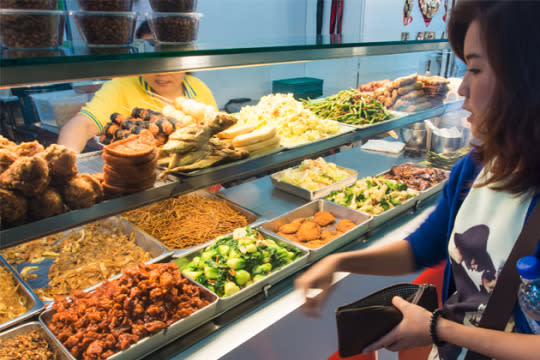COMMENTARY – Price caps will ruin hawker heritage

A hawker centre in Singapore. Social enterprise NTUC Foodfare, which runs the upcoming Bukit Panjang Hawker Centre and Market, said it would impose price ceilings on basic meals.
The planned price ceilings at the upcoming Bukit Panjang Hawker Centre and Market have triggered a debate on whether such a measure is commercially viable for hawkers and could discourage people from entering the trade.
Social enterprise NTUC Foodfare, the operator of the 35,000 sq ft hawker centre that is slated to open next year, announced on 13 July that it would impose price ceilings on basic meals.
This means dishes such as fish ball noodles, nasi lemak and chicken rice are capped at between S$2.50 and S$2.70, reported Channel News Asia.
The price ceilings for Western food are higher. For example, a plate of pasta will cost S$5.80.
The hawkers would also have to work longer hours too: stalls will be required to open at least six days a week and 12 hours a day.
To help hawkers meet this requirement, they can opt to have joint-operators at no additional cost.
NTUC Foodfare was appointed by the National Environment Agency (NEA) to operate the Bukit Panjang hawker centre, which is the second of 20 new hawker centres to be managed by social enterprises and cooperatives.
Its chief executive Perry Ong told The Straits Times, “People go to hawker centres for great food, variety and affordability and we think we can provide those things at Bukit Panjang.“
Those applying to operate the stalls will have to go through an elaborate tender process.
The rental bid submitted by an applicant for a cooked-food or market stall will make up only 40 per cent of the tender scorecard. The other 60 percent will be based on quality, variety, selling price, and the tenderer’s experience and business concept.
The tenders for the stalls closed on 3 August.
Keeping Costs Low?
NTUC Foodfare has said that it will help to keep costs low for hawkers.
For instance, they will get help in applying for grants to set up shop.
According to a recent Channel New Asia report, centralised dishwashing will be introduced at the hawker centre. NTUC Foodfare and the Employment and Employability Institute will ensure that the investment cost of centralised dishwashing is manageable while service and conservancy charges will be charged at cost.
The hawkers can also save on basic ingredients such as cooking oil, flour and eggs if they “take advantage of NTUC Foodfare’s bulk-purchasing power” but this suggestion has raised eyebrows.
Buying ingredients from NTUC Foodfare – which currently operates a catering service and runs 71 food courts, coffee shops, food kiosks and cafes across the country – only means more money for the operator.
But despite all these measures, can the hawkers at the centre really keep their costs low? Price caps also mean lower profit for stallholders so they probably have to work longer to turn in a decent profit. Longer hours also means more cost, especially when it comes to manpower.
And let’s face it; cheaper ingredients don’t always result in good food.
Not surprisingly, the price cap has attracted a lot of criticism online.
On July 26, one young hawker – who runs a stall at Golden Mile hawker centre – took to Facebook to lambast the move.
Douglas Ng said, “If the basic ingredients are so expensive, how can we expect hawkers to make a decent living? It is no wonder not many of the younger generation wants to take on the Hawker trade (sic).”
Ng has a point. Many hawkers prefer to source for their own materials as they feel that cheaper products might compromise on taste.
So instead of price caps, how about concession passes for seniors and low-income individuals instead?
Some of the hawkers have made such a suggestion if the intention is to make the hawker centre experience more inclusive.
Meanwhile, NTUC Foodfare said the limits would be reviewed from time to time if necessary. It would take into account the cost of ingredients and inflation.
According to a recent Today newspaper report, NTUC Foodfare said stallholders could also submit requests to adjust the price ceilings.
Let’s hope there’s more flexibility on this issue. After all, rigid rules could risk turning off many from joining the hawker trade and consequently, erode Singapore’s hawker heritage.

